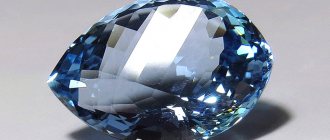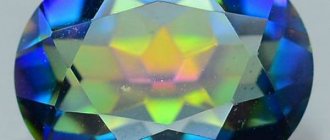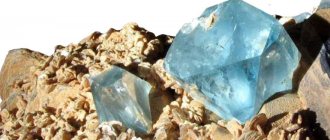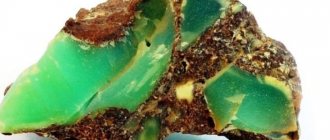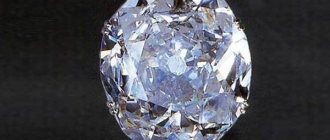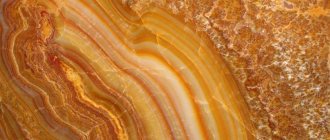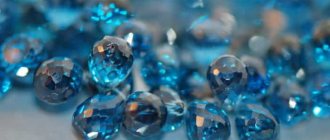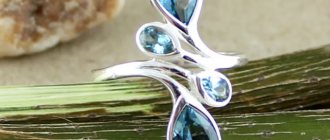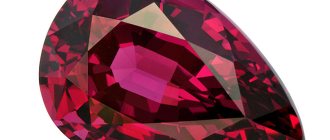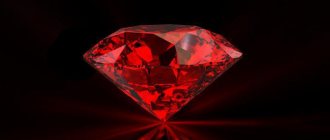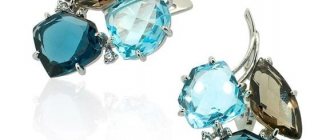When there is a desire to purchase such a beautiful gem as topaz, questions always arise: how much does a natural stone cost, what does its price depend on, and why one is more expensive and the other cheaper. We will share with you some basic knowledge about the qualities of this mineral so that you can understand how to evaluate topaz.
One of the remarkable natural properties of topaz is its ability to change color. Topaz has a crystalline structure, but differs from many crystals in that it changes color not because of the presence of foreign impurities in it, but because its crystals have errors in the design of their lattice. Modern specialists have mastered technologies for changing the color of topazes by heating them to certain temperatures, as well as using intense X-ray irradiation. If topaz is heated, it can become completely discolored and become transparent, and if it is exposed to radioactivity, it will acquire a thick and rich color.
Cost criterion - stone color
Transparent stones are priced according to certain criteria. This is the mass of the stone, the quality of its cut, the color itself and the purity of the crystal. The color and origin of the stone come first. There is a very high demand for stones of yellow, pink and orange-red colors.
It should be borne in mind that bright red topazes are almost never found in natural conditions, so their generally accepted price is very high. Since buyers often ask for rare crystals, craftsmen fall into temptation and begin to think about how to make an imitation of them. This is how all kinds of fakes appear on the market - both good and bad.
Therefore, it will not be superfluous to learn how to distinguish the real color of topaz from man-made, or simply fake. For example, natural pink topaz will cost much more than a stone of the same color, but produced artificially.
What are imperial topazes?
Imperial topaz is mined in Brazil and Pakistan. This stone is characterized by the following colors: pink, lotus color, yellow, orange, reddish. It is pink topaz that is the most expensive specimen of all. It costs up to $3,500 per carat. The yellow stone is cheaper, up to $500 per carat.
Cheaper options are topazes mined naturally, but colored by humans, in other words, processed by heat and other means. At the same time, even a processed crystal, the color of which has become pink, is more expensive than a natural blue stone.
Champagne: a more affordable color
In second place in terms of price and consumer demand is a group of stones of all possible yellow shades. Some are brownish in color with red or yellow hues. Their cost ranges from 25 to 70 dollars per carat.
Blue topazes: jewels to the masses
The cheapest topazes are of blue shades, and not always of natural origin. These colors are Sky Blue, Swiss Blue and London Blue.
How to care for topaz
Topaz is a very durable stone, so it is resistant to hard surfaces and chemicals other than sulfuric acid.
The main processing of topaz is exposure to high temperatures. Topazes may lose their color from sunlight and heat. Pink topazes and topazes of red and yellow shades fade faster, blue and green ones are more stable. Even transparent stones can become cloudy in the light and lose their transparency.
It is better to store topazes in dark, cool places and wear jewelry with these wonderful stones with caution on a sunny summer day.
How stones are given artificial shades
This may seem strange, but any pink specimen, even if its color is made artificially, is more expensive than natural blue - despite the fact that cool-colored crystals are more durable. This suggests that the rarity of the pink color of topaz in general, together with technological efforts (in human understanding), turns out to be more expensive than natural beauty.
But this superiority in price is only present if the artificial pink topaz weighs up to certain figures. If a stone weighs a maximum of 10 carats, there is a reason to repaint it, and the price for it will rise many times. But if the stone weighs more, such manipulations can harm it - due to the fact that larger stones are often characterized by uneven color distribution, or simply discoloration. For this reason, large topazes are often painted blue: they are more durable and reliable.
In Thailand, a 10-carat pink topaz costs between $10 and $15, while blue topaz (such as the London blue) costs only $5 to $10 per carat. Sky blue and Swiss blue crystals are much cheaper in Thailand.
Colorless crystals undergo artificial color correction before sale, because natural shades may not be so bright and expressive (gray, brownish or dirty milky). It is believed that it is impossible to make any jewelry from such stones, but they also have loyal fans who are ready to buy them without any processing.
Colorless topaz is also called white. Among them, specimens with intricate three-dimensional designs are of particular value. The rutile needles that create such patterns can be located randomly inside the crystal or, conversely, in a certain order, thereby creating amazing visual effects.
Mineral deposits
Topaz is a recognized Russian treasure. Colorless stones weighing up to 10 kilograms were found in large quantities in the Ilmensky, blue and yellow - in the Murzin-Adui gem belts, and bright blue, pink and crimson - in the Kochkar meganticlinorium (Southern Urals). Unfortunately, today these deposits have practically dried up, and the main volume of topaz production occurs in Brazil. Other stones are mined in Afghanistan and Germany, Norway and the USA, Namibia, Pakistan and Ukraine.
This is interesting!
For the first time in the Urals, a colorless gem was discovered at the beginning of the 19th century by the Cossack Prutov. In 1965, in Ukraine, in the mines of the Volodarsk-Volynsky pegmatite field, wine-yellow topaz weighing 117 kilograms was found. The largest finds were made in Brazil - gems weighing 5.8 tons and 238.4 kilograms.
Bright topazes are the cheapest
It is no secret that inexpensive but very beautiful mystic topaz, produced using magnetron sputtering with metal particles, is very popular among inexperienced buyers. A device called a magnetron was invented especially for this purpose. This is a generator of ultra-high frequency electromagnetic oscillations. Powerful radiation is directed at the stone, which “solders” metal molecules into the crystalline surface of the stone. As a result of this effect, the light flux is decomposed at the boundaries of the media, and an excellent picture of shades of the entire color spectrum is obtained.
Such stones are inexpensive, only five dollars per carat - partly because the result of processing with a magnetron emitter is short-lived. Conscientious and knowledgeable sellers immediately strongly recommend not to leave “mystical” topaz in places of direct sunlight, because its colors may fade.
The magical properties of topaz
The magic of stones is a mysterious but powerful thing. Almost all minerals of natural origin have magical abilities and topaz is no exception:
- Blue topaz has a dual effect, depending on the character of the owner. The stone does not like fools, liars and villains. For them, it can cause discord and failure. For honest and kind people, topaz is a symbol of love and success. It will help you find like-minded people, make friends, find your soulmate and strengthen your family, as well as achieve success in business and creative endeavors.
- The blue gem plays the role of a “fire extinguisher”. It helps to calm down, relieve nervous tension and get rid of outbursts of anger.
- Yellow and golden varieties symbolize gold, that is, material wealth. They attract him to their owner.
- Gems with a greenish tint are indispensable for worried and depressed people. They absorb all the negativity from the owner’s inner world. You can clean their energy by holding it in cold water for some time, which should then be poured into the sewer or onto the ground.
Shine and transparency of crystals
Both of these create the attractiveness of the decoration no less than the color indicator. If good polishing and grinding materials were used to process the crystal, it will appear smooth.
The purity of a crystal, which especially attracts the buyer's attention, is often also created by man-made means. Many stones mined in the natural environment do not have such transparency: they are usually translucent when exposed to light, as if filled with milk or cream. However, with the help of modern processing, people have learned to “control” the crystal lattice of topaz so that the stone becomes completely transparent.
But if such transparent topaz is reheated, it may return to its natural cloudy haze. This is why “mystical” topazes and other processed types of stones should not be left in places where there is direct sunlight.
As you can see, there are different topazes - both natural and those to which a particular color was given by the will of man. Of course, this is a matter of taste. Some people like cooler and more natural shades, while others are fans of inexpensive but amazingly beautiful mystic topaz, which is “afraid” of sunlight. Sometimes the color treatment is done so masterfully that there is simply no desire to call such products fakes. Many crystals are affordable, and if desired, you can choose a stone of any type - with the exception of those specimens that are still the rarest.
Physical and chemical properties
Topaz is a solid crystal whose chemical composition is aluminum fluorosilicate. It has perfect cleavage and is therefore very fragile. The rich color palette is determined not by the presence of impurities in the structure, but by its imperfection, that is, the presence of defects (O-vacancies of atoms give a blue color, F - yellow, and so on). There are polychrome topazes that combine several colors (most often blue/wine yellow). The stone has a high density and, accordingly, a high specific gravity, does not melt, does not dissolve in acids, decomposes only in a solution of phosphorus salt, and can lose color when exposed to heat and sunlight.
| Formula | Al2[SiO4](F,OH)2 |
| Impurities | Ferrous and trivalent iron, titanium, chromium and vanadium |
| Color | The color palette is varied - colorless, blue, yellow in different shades, golden, pink, orange and reddish-orange. There are polychrome varieties that combine two or more colors in one crystal. |
| Shine | Strong, glassy, |
| Hardness | 8 |
| Transparency | Transparent, less often translucent |
| Cleavage | Perfect by (001) |
| Strength | fragile |
| Kink | Rough to conchoidal |
| Density | 3.49-3.60 g/cm3 |
| Weight | Molecular -182.25, specific - 3.4-3.6 |
| Melting temperature | Doesn't melt |
| singonia | Rhombic |
| Crystal Shape | Prismatic, elongated along the axis to one degree or another |
| Refractive index | 1,606-1,639 |
Medicinal properties
The healing capabilities of the stone vary depending on its color:
- Colorless topazes increase immunity, resist attacks from viruses and infections, improve metabolism, fight insomnia, anemia, anemia, and gynecological ailments.
- Yellow gems overcome diseases of the throat and lungs, eliminate disorders in the gastrointestinal tract and central nervous system.
- Blue stones calm, relieve stress, and promote a speedy recovery from a depressive state. They also have a beneficial effect on the thyroid gland, reducing the risk of dangerous diseases associated with it.
- Topazes of other colors have a general positive effect on the entire body. They relieve stress, help get rid of fatigue, improve appetite and sleep, and also contribute to the speedy recovery of the patient from a variety of diseases - colds, gynecological, digestive, psychological and others.
